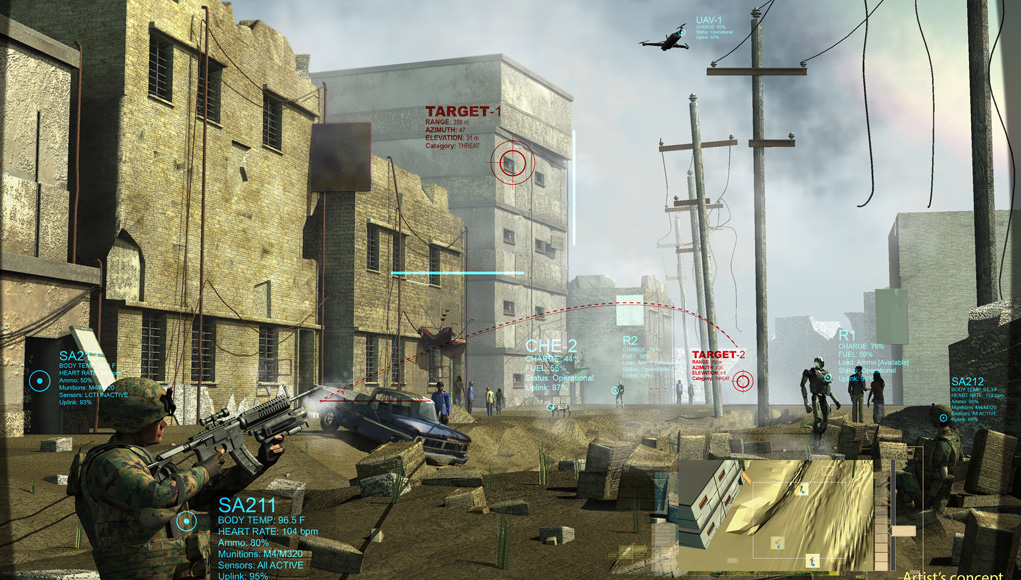Warfighters in aircraft, on ships and in ground vehicles have benefited tremendously from technological advances in recent decades, with advanced capabilities ranging from real-time situational awareness to precision armaments. But many of these benefits depend on equipment with substantial size, weight and power requirements, and so have remained unavailable to dismounted infantry squads who must carry all their equipment themselves. This gap leaves squad members without the degree of real-time situational awareness and support for decision-making that warfighters typically experience while on board aircraft and ships and in vehicles.
“We are working towards advanced capabilities that would make dismounted infantry squads more adaptable, safe and effective”
DARPA’s new ‘Squad X Core Technologies’ (SXCT) program aims to address this challenge and ensure that dismounted infantry squads maintain uncontested tactical superiority over potential adversaries without being overburdened by cumbersome hardware. The goal is to speed the development of new, lightweight, integrated systems that provide infantry squads unprecedented awareness, adaptability and flexibility in complex environments, and enable dismounted Soldiers and Marines to more intuitively understand and control their complex mission environments.
“SXCT aims to help dismounted infantry squads have deep awareness of what’s around them, detect threats from farther away and, when necessary, engage adversaries more quickly and precisely than ever before,” said Maj. Christopher Orlowski, DARPA program manager. “We are working towards advanced capabilities that would make dismounted infantry squads more adaptable, safe and effective.”
SXCT is seeking to introduce overwhelming tactical superiority at the small-unit level by enabling squad members to more quickly and effectively collect, synthesize and share data about their fellow members, their environment and potential threats without increasing physical or cognitive burdens.

Among the areas included in the program are:
- Precision Engagement: Precisely engage threats out to 0.6 mile (1,000 meters), while maintaining compatibility with infantry weapon systems and without imposing weight or operational burdens that would negatively affect mission effectiveness
- Non-Kinetic Engagement: Disrupt enemy command and control, communications and use of unmanned assets at a squad-relevant operational pace (walking with occasional bursts of speed)
- Squad Sensing: Detect potential threats out to 0.6 mile (1,000 meters) at a squad-relevant operational pace
- Squad Autonomy: Increase squad members’ real-time knowledge of their own and teammates’ locations to less than 20 feet (6 meters) in GPS-denied environments through collaboration with embedded unmanned air and ground systems
Specifically, Squad X plans to focus on providing:
- Integrated access to and control of mobile sensors, including full-motion streaming video
- A three-dimensional common operating picture
- The ability to organically locate and identify friendly forces and threat locations in near real time
- In previous request the agency also requested proposals for other focus areas including sensing technologies for warfighter health and operational status and non-optical and distributed sensing solutions.
Studies commissioned by Squad X program are to define the critical issues in Squad X implementation. The agency is also looking at critical infrastructure components such as radios, networking, computing applications, sensing, autonomous systems and size weight and power (SWaP). Integration Studies should also address Squad X architecture and integration approach. The goal is to establish an open, common, commercially extensible, government-owned architecture; defining key interfaces and standards; outlining the technology integration plan.
DARPA has scheduled a Proposers Day on Friday, February 27, 2015 to discuss the program with potential participants. In addition to the regular performers the agency invited ‘non-traditional performers’, including small businesses, academic and research institutions and first-time government contractors to participate. Special Notice document announcing the Proposers Day and describing the specific capabilities sought is available here.




















